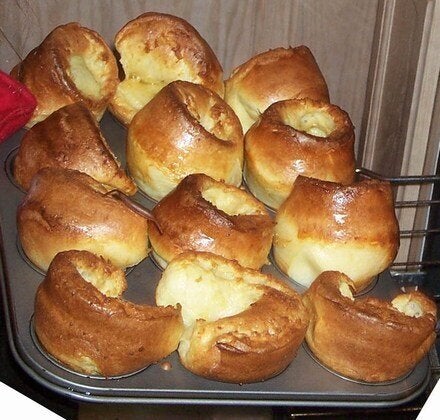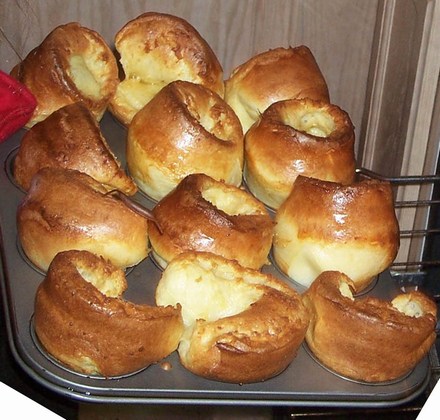
To me, holiday dinners are all about prime rib roast and especially the Yorkshire pudding made from luscious beef fat drippings. I can't even think about prime rib without thinking "Yorkshire pudding." They're a match made in culinary heaven. For the best rib roast you need a seriously marbled cut of meat, which is why it's good to go for prime grade. Marbling is what makes a rib roast so juicy and flavorful, and it's also what makes Yorkshire pudding possible.
While traditional Yorkshire pudding is made with the fat drippings from a beef rib roast, I've discovered that you can make a very savory Yorkshire pudding with duck fat as well. If you've ever made duck breast or roasted a whole duck, then you know how much fat it renders. I always save the fat from duck, it's way too good to toss out since you can substitute duck fat for butter in almost any savory recipe. And here, you can substitute it for the beef fat in Yorkshire pudding.
There are a few secrets to the perfect Yorkshire pudding though, and I give praise to my sister Nikki for her tremendous help in figuring them all out. This recipe makes the best Yorkshire pudding I've ever had (sorry, Lawry's Prime Rib), and I've had more Brits than I can count tell me it's the best they've ever had too (sorry, British mums). The pudding is light and rises super high, it's crispy on the outside and soft and fluffy on the inside, with just a trace of melted fat lining the middle and bottom. It's super easy, just follow it to the letter and you'll have a wonderful, savory bread to serve with roasted meats and poultry of all kinds... And if you store any extra fat in your fridge, you can whip up this special bread all winter long.

Picture-perfect Yorkshire pudding.
Yorkshire Pudding
Makes 12 standard muffin-sized puddings
120 g (1 cup) unbleached, all purpose flour
1 cup whole milk
2 large eggs
½ tsp coarse kosher salt
about ¼ cup duck or beef fat (liquid)
In the morning of the day you plan to make the Yorkshire pudding:
Whisk the 2 eggs with ½ cup of the milk, set aside.
In a large bowl, whisk the flour and salt together. Add the eggs and milk and whisk vigorously until there are absolutely no lumps left in the batter (and I mean none).
Cover the batter with plastic wrap and keep it at room temperature all day until you're ready to use it (at least 5 hours).
In the evening when you plan to serve the Yorkshire pudding:
Heat oven to 425 degrees F.
When the oven is heated, place a 12-muffin pan into the oven and heat it until the pan is very, very hot. Measure out one teaspoon of duck or beef fat into each muffin cup and place the pan back in the oven. Leave the pan in the oven until the fat is literally smoking hot. Really, it must be smoking. This usually takes about 5 minutes, but just look for the smoke.
As the fat is heating, whisk the remaining ½ cup cold milk into the batter that's been sitting out all day. The milk must be straight from the fridge cold. (When you make the batter in the morning, place a sticky tab on it that says "Add 1/2 cup cold milk" just to be sure you won't forget.) Whisk in some fresh, coarsely ground black pepper to taste. Put the batter into a vessel that makes it easy to pour.
When the fat is smoking--and I seriously mean smoking--take the muffin pan out of the oven and, working as quickly as possible, pour the batter evenly into the 12 cups. You'll see that when the batter hits the smoking hot fat it bubbles and sizzles. If it doesn't bubble and sizzle, then your fat wasn't smoking hot. You can't redo it at that point, and it will still taste good, it just won't rise as perfectly tall as it should... and it'll be a lesson learned for the next time you make Yorkshire pudding.
Immediately return the pan to the oven and bake for 20-25 minutes. Do not open the oven for the first 20 minutes of baking. The Yorkshire pudding is done when it is dark golden brown and dry to the touch, and it has risen very high. The inside of the pudding will look moist, this is fine.
Serve immediately. Yorkshire pudding is a bit like a soufflé in that you don't want to keep it waiting!
This recipe is easily doubled, tripled, or halved. Just be sure to use half the total quantity of milk for the batter you make in the morning, adding the remaining half of the total quantity of milk before baking.
Hints on Rendering Fat
Sometimes your rib roast may not want to render as much fat as you'll need for this recipe. So first, it's important to get a roast that has a lot of marbling, and to not trim off too much fat. Some tricks to get enough fat are to start your rib roast at a very high heat (450 F) for about 15 minutes before turning the heat down to 350 F. Also, you want to baste the rib roast with its fat. That's right, baste it like it was a bird, about every ten minutes. The initial high heat combined with the basting really coaxes that yummy fat out of the meat. If you're just doing a small roast, anything less than 4 ribs in it, then ask your butcher for some extra scraps of beef fat and toss them into the bottom of the roasting pan so you're sure to have enough melted fat for the pudding.
With duck, there's no worries. Just two duck breasts will render enough fat for 12 Yorkshire puddings. Be sure to score the fat for proper rendering, just don't cut into the meat below the fat. Also, you may want to pour your rendered fat (duck or beef) through a small fine sieve to remove any particles that might burn in the pudding.
Note: If you're making the rib roast as well as the Yorkshire pudding, as soon as the roast comes out of the oven, turn the temperature to 425 F and put the dry muffin pan straight in the oven, then follow the recipe above. Yorkshire pudding bakes for about 20-25 minutes, so the timing is perfect for when the roast is resting.